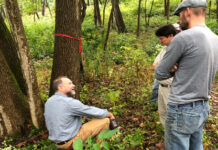At Cornell University, the Sustainable Landscapes Trail Program puts a focus on the campus’ environmental footprint.
 Launched in 2018, the Sustainable Landscapes Trail, overseen by both the Grounds and the Plant Science Departments, features meadows, trails, and other landscape elements to promote a healthy ecosystem on campus and beyond.
Launched in 2018, the Sustainable Landscapes Trail, overseen by both the Grounds and the Plant Science Departments, features meadows, trails, and other landscape elements to promote a healthy ecosystem on campus and beyond.
Dan Schied, Director of Grounds at Cornell University, shares the motivation behind these sites and upkeep requirements.
As the focus on healthy ecosystems continues to gain importance, colleges and universities are a significant resource to organizations as well as individuals for research and guidance. Classroom teachings and university extensions are important resources, while the physical campus landscape may serve as a living laboratory. At Cornell University in Ithaca, NY, a focus on “landscape sustainability” has served to bring together faculty and staff across several departments. Nina Bassuk, PhD, professor at Cornell’s School of Integrative Plant Science Horticulture Section, oversees the Sustainable Landscapes Trail program with David Cutter, University landscape architect. Bassuk explains: “Cornell defines ‘landscape sustainability’ as the design, construction, operation, and management of campus grounds to enhance and promote healthy ecosystems. Healthy ecosystems provide ecosystem services. A sustainable landscape on our campus is also a part of our ‘living laboratory campus’ – meaning each site can be used for research and education, and was designed using Cornell research or student class projects as part of their implementation.”
 Turf spoke with Dan Schied, Cornell’s director of grounds, about the Libe Slope Meadow on campus to understand the background and landscape maintenance there. He also shares a peek into a new planned meadow at Cornell.
Turf spoke with Dan Schied, Cornell’s director of grounds, about the Libe Slope Meadow on campus to understand the background and landscape maintenance there. He also shares a peek into a new planned meadow at Cornell.
Libe Slope Meadow is the first to be established on the Cornell campus. When did this happen, and what are its key features?
Libe Slope is one of numerous meadows on campus, although likely the largest, along with the arboretum meadow. It was started in 2008-2009 as a result of increased emphasis on sustainable practices along with an economic downturn affecting campus budgets and staffing levels. It was a win/win situation at the time, and its ongoing success has motivated us to look at other areas on campus—primarily sloped locations that are difficult to mow.
What is the maintenance program for Libe Slope Meadow?
Each of the meadow locations gets mowed just once a year between August and October, many with a radio-controlled slope mower for safety. No chemical treatments or supplemental irrigation is used. The annual mowing reduces woody and other invasives from taking hold.
Any observations to share since the grounds department has been caring for Libe Slope Meadow? Significant water savings? Less labor required?
There is no water use on any meadow. And weekly mowing has been eliminated through creation of this and the other meadows. The once-a-year mowing does take longer, but we definitely see labor savings as a whole.
Have you encountered challenges? What has been the response in the university community?
Response from the community has gotten more positive as we use our “Tall Grass/Small Gas” information signs to educate on carbon reduction and pollinator habitat. There was concern over the potential for ticks in these areas, but there is no reason for anyone to enter. And, if there is a desired shortcut, we mow a pathway through the landscape. For example, a significant pathway is maintained in the arboretum meadow.
Tell us about the Botanic Gardens Native Lawn on campus.
Planted in 2009 and continuing today, this site was designed to demonstrate how well native plants can thrive and perform as meadow areas, with fewer pesticides and chemicals. The site was used as a model for a high-performing replacement for traditional lawns. Native lawns are created with short and slow growing native grass species that require less irrigation and are more likely to be resistant to weeds, pests, and fungus. The initial installation and establishment of the grass is a crucial part to the success and sustainability of a native lawn.
Looking ahead, are you planning other meadows on campus?
We are currently in the process of adding a new meadow at our Dyce Bee Lab, which is located outside the main campus. We are working in conjunction with a new student group, Cornell BeeCampus, to reduce mowing and add a few specific pollinator seed mixes for research and public use.


Learn more about the Sustainable Landscapes Trail at Cornell University here. For more about the Grounds Department, part of Facilities and Campus Services, click here.
Do you have a comment? Share your thoughts in the Comments section below, or send an e-mail to the Editor at acosgrove@groupc.com.
Click here to read more My Landscape articles from Turf magazine.











![[VIDEO] Dickies®: Discover Workwear That’s Anything But Uniform](https://turfmagazine.com/wp-content/uploads/2023/06/1647663814-4b1a2a7742790a9b1e97a3b963477850192e1d6a9dfba9b07214a77bae25d6e3-d-218x150.jpg)

























 Launched in 2018, the Sustainable Landscapes Trail, overseen by both the Grounds and the Plant Science Departments, features meadows, trails, and other landscape elements to promote a healthy ecosystem on campus and beyond.
Launched in 2018, the Sustainable Landscapes Trail, overseen by both the Grounds and the Plant Science Departments, features meadows, trails, and other landscape elements to promote a healthy ecosystem on campus and beyond.

![[VIDEO] Dickies®: Discover Workwear That’s Anything But Uniform](https://turfmagazine.com/wp-content/uploads/2023/06/1647663814-4b1a2a7742790a9b1e97a3b963477850192e1d6a9dfba9b07214a77bae25d6e3-d-324x160.jpg)
show how well native plants can thrive and perform in meadow areas with fewer pesticides and chemicals